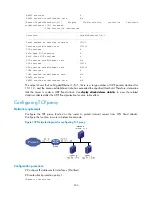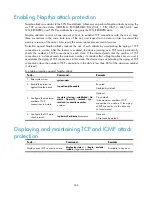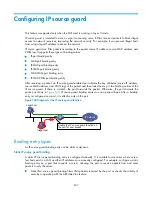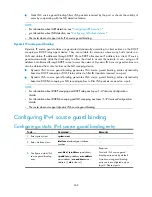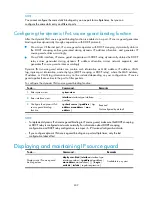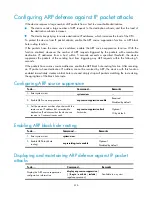
415
Configuring ARP attack protection
Although ARP is easy to implement, it provides no security mechanism and thus is prone to network
attacks. An attacker may send the following:
•
ARP packets by acting as a trusted user or gateway so that the receiving devices obtain incorrect
ARP entries.
•
A large number of IP packets with unreachable destinations. As a result, the receiving device
continuously resolves destination IP addresses and thus its CPU is overloaded.
•
A large number of ARP packets to overload the CPU of the receiving device.
For more information, see
ARP Attack Protection Technology White Paper
.
ARP attacks and viruses threaten LAN security. The device can provide multiple features to detect and
prevent such attacks. This chapter mainly introduces these features.
Configuration task list
Task Remarks
Flood
prevention
Configuring ARP
source suppression
Optional
Configure this function on gateways
(recommended).
Enabling ARP black
hole routing
Optional
Configure this function on gateways
(recommended).
Configuring ARP active
acknowledgement
Optional
Configure this function on gateways
(recommended).
Optional
Configure this function on gateways
(recommended).
Optional
Configure this function on access devices
(recommended).
Configuring ARP automatic scanning
and fixed ARP
Optional
Configure this function on gateways
(recommended).
Configuring ARP gateway protection
Optional
Configure this function on access devices
(recommended).
Optional
Configure this function on access devices
(recommended).



